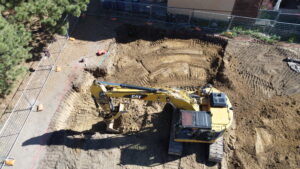When selecting a foundation system, one of the key considerations is whether to use deep foundations or shallow foundations. Let’s compare these two types of foundations to understand their differences and the situations in which each is most suitable.
Depth of Embedment
Deep Foundations: Deep foundations are designed to transfer loads to deeper soil layers or rock formations. They are typically embedded several feet below the ground surface, reaching into more stable strata.
Shallow Foundations: Shallow foundations, as the name suggests, are situated closer to the ground surface and typically have a depth that is less than the width of the foundation. They rely on the bearing capacity of the near-surface soils to support the loads.
Load-Bearing Capacity
Deep Foundations: Deep foundations are specifically designed to support heavy vertical loads. They can carry significant loads due to their ability to reach deeper, more competent soil layers or bedrock.
Shallow Foundations: Shallow foundations have a relatively lower load-bearing capacity compared to deep foundations. They are suitable for lighter structures or when the soil conditions near the surface are strong enough to support the loads.
Suitability for Challenging Soil Conditions
Deep Foundations: Deep foundations are commonly used in situations where the upper layers of soil are weak, compressible, or prone to settlement. They provide a stable support system by bypassing the problematic soil layers and transferring the loads to more competent soil or rock layers.
Shallow Foundations: Shallow foundations are typically used when the soil near the surface is sufficiently strong and stable to support the structure without excessive settlement. They are suitable for stable soil conditions with good bearing capacity.
Construction Complexity
Deep Foundations: The construction of deep foundations often involves specialized equipment and techniques. Drilling, driving, or excavating to significant depths requires skilled professionals and specific machinery, making the construction process more complex and time-consuming.
Shallow Foundations: Shallow foundations are relatively easier and faster to construct compared to deep foundations. Excavation, leveling, and pouring concrete are the primary steps involved in constructing shallow foundations.
Cost Considerations
Deep Foundations: Deep foundations tend to be more expensive than shallow foundations due to the additional materials, equipment, and labor required for their construction. The cost increases further when challenging soil conditions or specialized foundation systems are involved.
Shallow Foundations: Shallow foundations are generally more cost-effective, especially when the soil conditions near the surface are suitable for supporting the loads. The simplicity of the construction process contributes to reduced costs.
Flexibility and Adaptability
Deep Foundations: Deep foundations offer greater flexibility in terms of accommodating various soil conditions and load requirements. Different types of deep foundations can be selected based on site-specific considerations, allowing for customized solutions.
Shallow Foundations: Shallow foundations have limited adaptability as they heavily rely on the bearing capacity of near-surface soils. If the soil conditions are unsuitable, extensive soil improvement techniques may be required, which can increase costs and complexity.
Ready to learn more?
Deep Foundations, Part One: Intro
Deep Foundations, Part Three: Types
Deep Foundations, Part Four: Type Comparisons
Different Structural Foundation Types
Straight Shaft Drilled Concrete Pier Foundation










